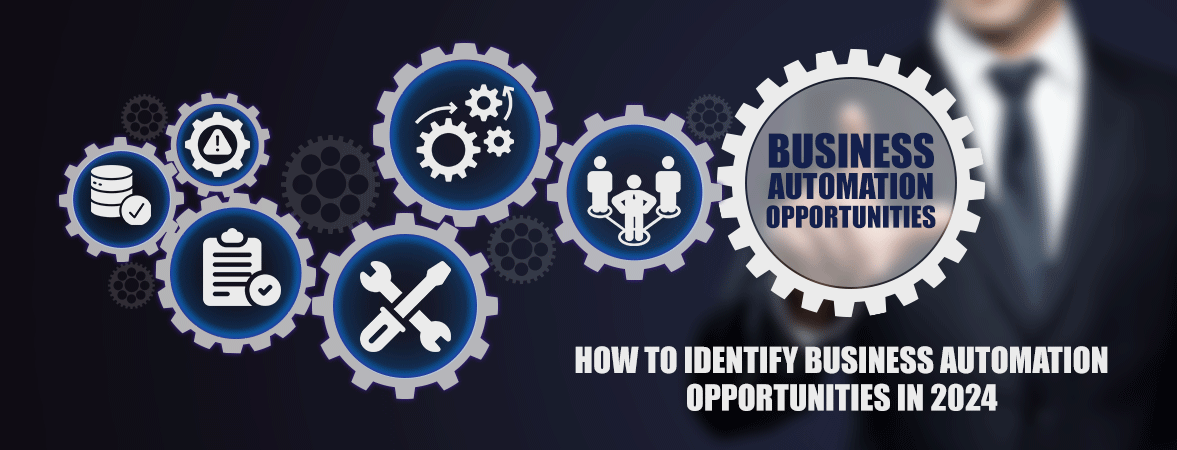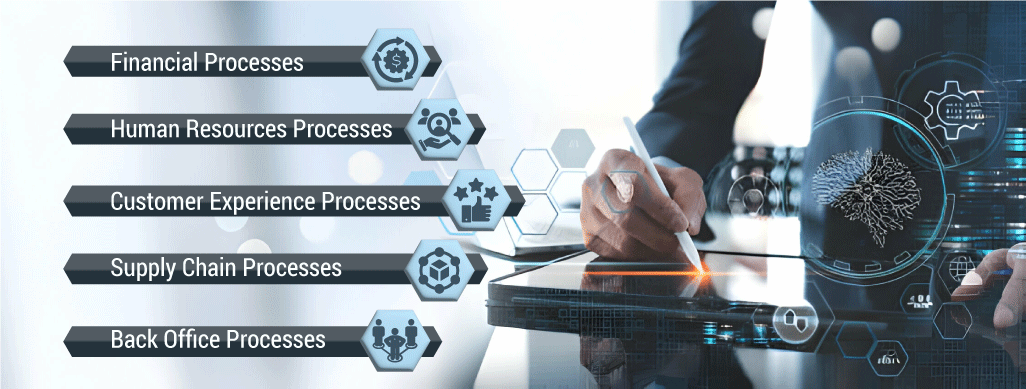
We use cookies to ensure that we give you the best experience on our website.
By using this site, you agree to our use of cookies. Find out more.
In this blog post, we will explore how leaders can better identify and prioritize where introducing or expanding automation can further enhance operations.

As we enter the new year of 2024, business process automation continues to accelerate as a critical strategic tool for optimization and growth. While many organizations have already implemented automation solutions to streamline routines and gain competitive advantages, untapped opportunities remain undiscovered across functional areas. In this blog post, we will explore how leaders can better identify and prioritize where introducing or expanding automation can further enhance operations. We'll define what business process automation is and why it delivers such value. We'll also analyze the five key departments that commonly present the highest potential for new automation initiatives - customer experience, HR, finance, supply chain and back office. By conducting thorough assessments with automation potentials in mind, businesses can emerge stronger as the economy and marketplace evolve.
Business process automation refers to the application of technology to manage routine or repeatable tasks and workflows within an organization. The goal is to digitize manual processes that are time-consuming, labor-intensive or error-prone when performed by people. By leveraging software robots, artificial intelligence and other digital tools, common administrative and operational processes can be automated to streamline how work gets done. This allows employees to reallocate time from repetitive duties to more strategic work requiring human judgment and creativity.
Processes that are well-defined, standardized and predicated on set rules and conditions tend to be the best candidates for automation. Common examples include data entry, payment processing, records management and basic customer service inquiries. Automating these transactional workflows boosts productivity, cuts costs and minimizes delays from human bottlenecks or errors. Advanced technologies like robotic process automation use machine learning and artificial intelligence to seamlessly integrate multiple legacy systems while replicating human decision-making within structured processes. This achieves end-to-end process automation across departments for maximum efficiencies.
There are several key reasons why automating processes through technology such as robotic process automation, artificial intelligence and cloud-based software tools is important for businesses. Automation allows businesses to improve efficiency by reducing the amount of time spent on manual, repetitive tasks. This frees up employees to focus on more strategic work that requires human judgment and interactions. Automation also helps improve accuracy by reducing human errors. Important processes can be completed uniformly according to set standards and compliance requirements. Automation enhances productivity and helps scale business operations more effectively to support growth. It reduces costs by lowering labor expenses associated with manual tasks. Automated processes also improve the customer and employee experience through faster, more consistent services. Insights from automated data capture and reporting can help optimize processes over time. Overall, process automation enables businesses to work smarter and gain a competitive edge.
Here are the 5 key areas to focus on for automation opportunities:

Automating customer experience processes can effectively streamline interactions across multiple channels. Business process automation services like interactive voice response systems, virtual agents and chatbots can handle large volumes of simple inquiries and requests, freeing up live agent resources. These digital assistants are capable of addressing basic questions, fulfilling orders, and providing light technical support at any time of day. As artificial intelligence improves, virtual agents will get better at understanding complex customer needs and routing more difficult issues to human agents. With automation taking over basic repetitive tasks, live customer service teams can spend more meaningful timesolving complex problems and building strong customer relationships.
Additionally, back-end automation can accelerate processes like data entry, payment processing and order fulfillment that often bog down customer workflows. Robotic process automation excels at carrying out rule-based activities consistently and rapidly, unlike human staff prone to fatigue or distraction. Integrating front and back-office systems through APIs allows seamless transfer of customer information between interactive conversations, ordering systems and order fulfillment operations. Implementing workflow automation streamlines handoffs between automated and human-handled customer interactions. By eliminating bottlenecks and ensuring continuity of service, businesses can elevate the overall customer experience through coordinated front and back-end automation.
There are many repetitive tasks within human resources that can benefit greatly from business process automation services. Automating administrative activities like time tracking, payroll processing and benefits enrollment takes time-intensive manual work off the plates of HR teams. Robotic process automation can manage a high volume of employee data updates and form submissions with perfect accuracy. This allows HR professionals to focus more on strategic initiatives that improve both the employee experience and business performance. For example, with time-consuming clerical work addressed, HR can devote greater resources to developing tailored training programs or implementing innovative recruiting strategies.
Automation also enables self-service options that empower employees. Business process automation streamlines tasks like time-off requests, expense reporting and performance reviews through electronic forms and workflow tools. Employees have 24/7 access to manage simple HR transactions through a user-friendly portal. This improves convenience and satisfaction by allowing issues to be addressed on the employee's own time. Automated reminders and approvals keep processes moving efficiently. Overall, companies that automate standardized HR operations with tools tailored for process automation gain better employee engagement and retention through an improved HR experience.
Financial operations are ripe for streamlining through business process automation software. Manual paper-based processes like invoice receipt and data entry cause delays and increase the risk of human error. Accounts payable automation software tackles these inefficiencies by capturing invoices through optical character recognition or intelligent data capture. Invoices are automatically coded and routed electronically based on predefined business rules. This eliminates time-consuming manual handling and frees up staff to focus on more strategic financial analysis. Automated invoice processing and workflow routing slashes processing times while enhancing accuracy.
Robotic process automation also improves efficiency for recurring accounting tasks such as bank reconciliations, payroll processing and monthly financial reporting. RPA software executes rule-based activities quickly and precisely by mimicking human actions within financial systems. They can consolidate data from multiple ERP and accounting platforms to generate real-time insights. Automating sequential financial processes in this way reduces processing time from weeks to days, enabling faster decision-making. The data captured through automated workflows serves as clean, compliant inputs for operational and strategic analysis. Automation streamlines financial operations to support effective planning, budgeting and cost management.
Supply chain management relies on the timely flow of information between suppliers, manufacturers, warehouses and customers. Business process automation tools are invaluable for synchronizing data across every link in the supply chain. Integrating ERP, WMS and TMS platforms through APIs allows purchase orders, inventory levels and fulfillment status to be updated automatically in real-time. This gives managers a holistic view of material availability and delivery schedules. Automated replenishment software also triggers reorder alerts to ensure stock is maintained without human intervention. Robotic bots deployed to monitor demand and execute transactions ensure supply and demand are balanced precisely.
Advanced automation tools apply machine learning to forecast demand, predict delays and recommend mitigating actions. Automated fulfillment processes dispatch orders instantly, select optimal routes and print shipping documents with little manual data entry. AI assistants schedule logistics, track shipments and notify customers of delays or changes. Computer vision even inspects items and detects defects. This level of end-to-end optimization would be impossible without business process automation streamlining every handoff and exception handling. Automation creates an nimble, demand-driven supply chain that enhances competitiveness through improved fulfillment rates, inventory turns and customer satisfaction.
Many back office tasks are repetitive in nature and well-suited for business process automation tools. Robotic process automation tools can centralize activities like invoice filing, facilities maintenance coordination and office supply procurement. By logging into various backend systems, bots mimic human actions to process paperwork, schedule maintenance visits, and place orders. This allows staff to focus on more strategic administrative work. Automating time-consuming transactional chores frees up capacity for higher-value initiatives.
Automation also streamlines document-centric workflows. Business process automation software with robotic process automation and optical character recognition converts paper records into searchable digital files. Data from bills, contracts and reports is captured, validated and populated directly into systems of record. Automated classification routes files to correct departments based on metadata. Centralizing paper-based records digitally through process automation improves searchability, reduces storage costs and ensures compliance by removing human error from document processing and retention. Teams are more efficient with fast access to information when and where needed.
The coming year offers tremendous opportunities for companies that proactively seek out and pursue automation where it makes the most strategic sense. While certain processes will always require human skills and judgment, even more can be optimized through the right digital and AI-driven tools. Taking a holistic enterprise view and empowering cross-functional teams to evaluate automation fits will uncover savings, efficiencies and competitive advantages that may not be obvious. Those who invest in systematically identifying and executing prioritized automation projects positioned around core capabilities and customer needs will drive meaningful impact to their operations and business performance in 2024 and beyond.
Leave a Comment
Your email address will not be published.